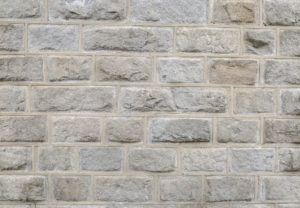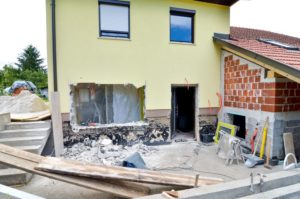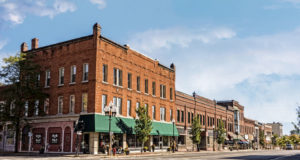Category: Masonry Services
Tips about How to Prepare for Building Restoration
Renovating your home is a great way to make your space more attractive and more functional, but it is a huge project that involves the prolonged discomfort and disruption to your daily routines, so you need to prepare for it thoroughly. Here are some tips that can help you:
- Determine your goals and stick to them – one of the things that can prolong the renovation process endlessly is that as the work progresses, you will discover new issues that need to be tackled. To prevent that from happening, perform a thorough evaluation of the issues that need to be solved before the project starts, create a roadmap that includes all of them and stick to that plan;
- Determine your budget – perform a realistic evaluation of your financial situation and tackle only renovations that fit into that budget;
- Plan for the disruption – try to make plans for how you are going to live with the mess generated by the renovation process. Determine how and where you are going to move the items from the room that is being renovated and what you are going to do when an important system, such as the water or the electricity, needs to be disconnected for a specific phase in the renovation process. This is true for exterior renovations like Connecticut masonry restoration projects, taking into consideration the time of year.
How Do You Protect Your Masonry from Severe Weather Changes?
Weather changes are some of the most problematic factors that can lead to damaging a building or any type of structure that uses masonry. Regardless of how well-designed it was, the masonry in question still isn’t made to last forever. Sooner or later, without proper care and maintenance, it can lose the battle of the elements and require a complete makeover in the end.
To prevent that, it’s important to take a few steps to protect your masonry from severe weather changes:
- One of the first things you can do is hire a dependable mason who is well-acquainted with modern methods for keeping newly constructed Connecticut masonry protected. In most cases, they will suggest covering the masonry with a special type of weather-resistant coating for 24 hours after the masonry work was completed.
- If the bricklaying work associated with a masonry project is not yet completed, and the temperature drops below 3 Celsius degrees, it’s important to stop and resume again when the temperature increases to more than 3 degrees.
- A freshly laid brick wall can also be protected from a sudden downpour by using terpaulin sheets. Make sure you check the weather forecast on a regular basis, and lay out the sheets whenever the forecast predicts rainfall.
Understanding the Process of Masonry Restoration and What It Entails
Masonry restoration and repair can be a difficult process at the best of times. You’ll need to hire experts who specialize in it and who can provide you with the best services in your area. Aside from that, even understanding the process itself can be a bit tricky, but you will have to learn as much as you can about it, if you want to make an informed decision regarding who to hire for the job.
The term “masonry restoration” refers to the work performed on any and all types of masonry that exists within a building or a home. If the masonry requires renewal or repair, a masonry restoration expert will usually be called in to assess the damage, determine the best method with which to proceed, and provide the owner of the building or house with an estimate on how much the work will cost.
The object of masonry restoration is to make a building look as good as new or even better than it was when it was new. Since many buildings that require this service are quite old, and since the materials used and the approach to masonry that masons use today will be quite different than those 50 or even 20 years ago, the process of masonry restoration will also differ.
Typically, however, the mason will use methods such as repointing – which is the process of replacing some or all of the mortar used for a certain joint – and various types of upgrades to ensure that the building can withstand an earthquake, a fire or a certain degree of water damage better than before.
The Major Signs That Your Masonry Has Been Damaged by Hail
Hail is a major concern for a number of areas around the exterior of your home. Aside from affecting gardens and roofs, hail can also fall at an angle and damage the side of your home. If you own brittle masonry that can easily be damaged, and there are no trees to block the hail’s falling trajectory, then it should be pretty easy to spot the signs that your masonry has been damaged by hail and in need of a Connecticut masonry repair:
- The first signs you’ll see will be visible ones. Masonry and brick veneer as well as similar types of siding, can be chipped, pitted and even cracked during a hail storm, leading to the need for replacing certain parts of the masonry or even the restructuring of an entire wall.
- Hail damage signs become clearer when you observe the direction of the wind during or right after a hail storm. If the wind and the perceived trajectory of the hail matches the impact signs on your home’s exterior walls, then any chips, dents and cracks you might find were likely created by the hail’s impact.
- Some types of masonry can also lose some of its color in certain areas as a result of hail exposure. Because of the impact of smaller pieces in a denser formation on your walls, the strength of the individual impacts might not be enough to damage the masonry, but it might be enough to discolor it.
Increasing The Longevity Of Your Historic Building
The main advantages of consolidating a building are the substantial reduction of seismic risk and the increase of its longevity. A historic building has a great architectural value, which must be preserved.
Consolidation works vary from one building to another, depending on age, damage, and materials from which it was built. Older buildings generally have a resistance structure made from load-bearing masonry, which means that the gravitational and seismic forces are taken over by the walls. As such, damage that occurs over time varies from cracks to crushed walls. The most common solution for such problems would be to consolidate the walls by covering them with reinforced concrete, on one or both sides.
However, in the case of historically important buildings, this consolidation method is not recommended because the shape, size and materials used in the original construction must be preserved. The consolidation of a historic building involves the restoration of the cracked wall, which leads to finding the best Connecticut masonry local expert, the injection of cracks and the insertion of mortar into the wall.
Before making the decision to consolidate and restore a historic building, you need to call on specialists to assess the construction and determine the best solutions. You also need to get the necessary permits.






















